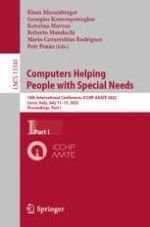2022 | OriginalPaper | Buchkapitel
Non-verbal Communication and Joint Attention Between People with and Without Visual Impairments: Deriving Guidelines for Inclusive Conversations in Virtual Realities
verfasst von : Markus Wieland, Lauren Thevin, Albrecht Schmidt, Tonja Machulla
Erschienen in: Computers Helping People with Special Needs
Aktivieren Sie unsere intelligente Suche, um passende Fachinhalte oder Patente zu finden.
Wählen Sie Textabschnitte aus um mit Künstlicher Intelligenz passenden Patente zu finden. powered by
Markieren Sie Textabschnitte, um KI-gestützt weitere passende Inhalte zu finden. powered by
